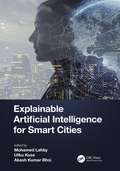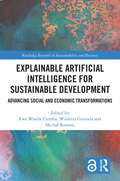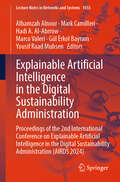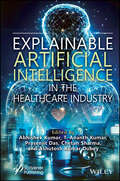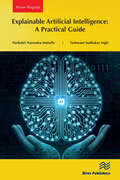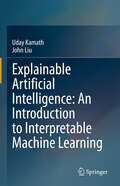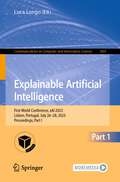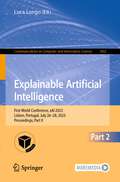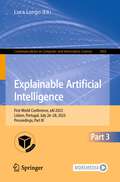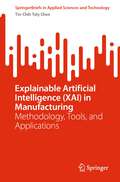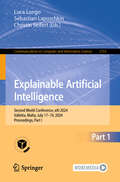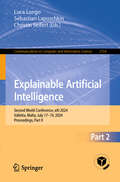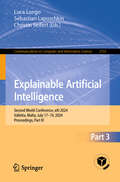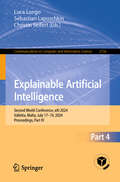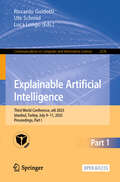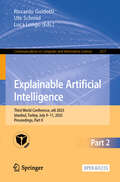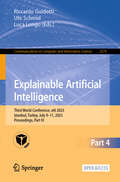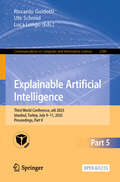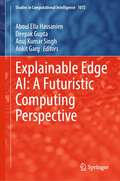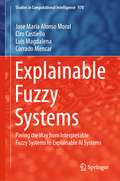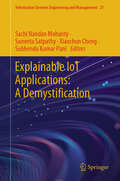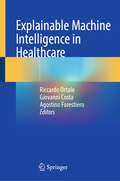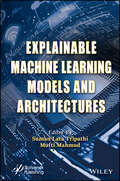- Table View
- List View
Explainable Artificial Intelligence for Smart Cities
by Mohamed LahbyThanks to rapid technological developments in terms of Computational Intelligence, smart tools have been playing active roles in daily life. It is clear that the 21st century has brought about many advantages in using high-level computation and communication solutions to deal with real-world problems; however, more technologies bring more changes to society. In this sense, the concept of smart cities has been a widely discussed topic in terms of society and Artificial Intelligence-oriented research efforts. The rise of smart cities is a transformation of both community and technology use habits, and there are many different research orientations to shape a better future. The objective of this book is to focus on Explainable Artificial Intelligence (XAI) in smart city development. As recently designed, advanced smart systems require intense use of complex computational solutions (i.e., Deep Learning, Big Data, IoT architectures), the mechanisms of these systems become ‘black-box’ to users. As this means that there is no clear clue about what is going on within these systems, anxieties regarding ensuring trustworthy tools also rise. In recent years, attempts have been made to solve this issue with the additional use of XAI methods to improve transparency levels. This book provides a timely, global reference source about cutting-edge research efforts to ensure the XAI factor in smart city-oriented developments. The book includes both positive and negative outcomes, as well as future insights and the societal and technical aspects of XAI-based smart city research efforts. This book contains nineteen contributions beginning with a presentation of the background of XAI techniques and sustainable smart-city applications. It then continues with chapters discussing XAI for Smart Healthcare, Smart Education, Smart Transportation, Smart Environment, Smart Urbanization and Governance, and Cyber Security for Smart Cities.
Explainable Artificial Intelligence for Sustainable Development: Advancing Social and Economic Transformations (Routledge Research in Sustainability and Business)
by Ewa Wanda Ziemba Wioletta Grzenda Michał RamszaThis book explores how transparent, interpretable AI technologies can support sustainable progress across industries and societies. It brings together theoretical foundations and practical applications of explainable AI (XAI) aligned with the UN’s Sustainable Development Goals (SDGs), offering insights into its potential for responsible innovation.It provides a comprehensive understanding of how explainable AI enhances trust, ethics, and accountability in AI-driven decisions. Through diverse case studies — from banking, e-commerce, and sustainability reporting, to psychiatry, education, and energy—the book demonstrates XAI’s transformative role in driving sustainable business practices and societal well-being. Each chapter merges cutting-edge research with real-world examples, making complex AI systems more accessible and socially relevant. The book bridges gaps between disciplines, offering a holistic and actionable perspective on AI for sustainability.This book is a vital resource for researchers, professionals, and policymakers seeking to harness AI responsibly. Academics in social sciences, economics, and information systems will find a strong theoretical base, while practitioners in business, government, and NGOs gain practical tools for implementing XAI in real contexts. It is also well-suited for students, educators, and AI enthusiasts aiming to align innovation with sustainable, ethical transformation.
Explainable Artificial Intelligence for Trustworthy Decisions in Smart Applications
by Nicu Bizon Bhargav AppasaniThis book introduces readers to the field of explainable artificial intelligence (XAI), which aims to make AI models more transparent and trustworthy. It explores how XAI can enhance trust and confidence in AI models and their decisions across various innovative applications in fields such as healthcare, finance, and engineering, where AI can significantly impact quality of life. Readers will discover emerging trends related to XAI—such as large language models, generative AI, and natural language processing—that are transforming the landscape of AI research and applications. Featuring an interdisciplinary overview, the book examines the state of the art, challenges, and opportunities in XAI, accompanied by clear examples and detailed explanations of its methods and techniques. The book also offers a balanced perspective on the limitations and trade-offs of XAI and outlines future directions and opportunities for both research and practice. This book is intended for anyone who wants to learn more about XAI and understand how it can enhance trust in AI models.
Explainable Artificial Intelligence in Medical Imaging: Fundamentals and Applications (Advances in Computational Collective Intelligence)
by Tanzila Saba Amjad Rehman KhanArtificial intelligence (AI) in medicine is rising, and it holds tremendous potential for more accurate findings and novel solutions to complicated medical issues. Biomedical AI has potential, especially in the context of precision medicine, in the healthcare industry’s next phase of development and advancement. Integration of AI research into precision medicine is the future; however, the human component must always be considered.Explainable Artificial Intelligence in Medical Imaging: Fundamentals and Applications focuses on the most recent developments in applying artificial intelligence and data science to health care and medical imaging. Explainable artificial intelligence is a well-structured, adaptable technology that generates impartial, optimistic results. New healthcare applications for explicable artificial intelligence include clinical trial matching, continuous healthcare monitoring, probabilistic evolutions, and evidence-based mechanisms. This book overviews the principles, methods, issues, challenges, opportunities, and the most recent research findings. It makes the emerging topics of digital health and explainable AI in health care and medical imaging accessible to a wide audience by presenting various practical applications.Presenting a thorough review of state-of-the-art techniques for precise analysis and diagnosis, the book emphasizes explainable artificial intelligence and its applications in healthcare. The book also discusses computational vision processing methods that manage complicated data, including physiological data, electronic medical records, and medical imaging data, enabling early prediction. Researchers, academics, business professionals, health practitioners, and students all can benefit from this book’s insights and coverage.
Explainable Artificial Intelligence in the Digital Sustainability Administration: Proceedings of the 2nd International Conference on Explainable Artificial Intelligence in the Digital Sustainability Administration (AIRDS 2024) (Lecture Notes in Networks and Systems #1033)
by Gül Erkol Bayram Marco Valeri Alhamzah Alnoor Mark Camilleri Hadi A. Al-Abrrow Yousif Raad MuhsenThis book explores current research trends in the context of the explainable artificial intelligence’s impact on the digital sustainability trend while delving into case studies on education, tourism, marketing, and finance. These trends are examined through various case studies utilizing distinct analytical methods. The chapters are expected to support scholars and postgraduate students in furthering their research in this field and in recognizing prospective advancements in the applications of artificial intelligence.
Explainable Artificial Intelligence in the Healthcare Industry
by Abhishek Kumar Chetan Sharma Ashutosh Kumar Dubey Prasenjit Das T. Ananth KumarDiscover the essential insights and practical applications of explainable AI in healthcare that will empower professionals and enhance patient trust with Explainable AI in the Healthcare Industry, a must-have resource. Explainable AI (XAI) has significant implications for the healthcare industry, where trust, accountability, and interpretability are crucial factors for the adoption of artificial intelligence. XAI techniques in healthcare aim to provide clear and understandable explanations for AI-driven decisions, helping healthcare professionals, patients, and regulatory bodies to better comprehend and trust the AI models’ outputs. Explainable AI in the Healthcare Industry presents a comprehensive exploration of the critical role of explainable AI in revolutionizing the healthcare industry. With the rapid integration of AI-driven solutions in medical practice, understanding how these models arrive at their decisions is of paramount importance. The book delves into the principles, methodologies, and practical applications of XAI techniques specifically tailored for healthcare settings.
Explainable Artificial Intelligence: A Practical Guide (River Publishers Rapids Series on Intelligence in Chips)
by Parikshit Narendra Mahalle Yashwant Sudhakar IngleThis book explores the growing focus on artificial intelligence (AI) systems in both industry and academia. It evaluates and justifies AI applications while enhancing trust in AI outcomes and aiding comprehension of AI feature development. Key topics include an overview of explainable AI, black box model understanding, interpretability techniques, practical XAI applications, and future trends and challenges in XAI.Technical topics discussed in the book include: Explainable AI overview Understanding black box models Techniques for model interpretability Practical applications of XAI Future trends and challenges in XAI
Explainable Artificial Intelligence: An Introduction to Interpretable Machine Learning
by Uday Kamath John LiuThis book is written both for readers entering the field, and for practitioners with a background in AI and an interest in developing real-world applications. The book is a great resource for practitioners and researchers in both industry and academia, and the discussed case studies and associated material can serve as inspiration for a variety of projects and hands-on assignments in a classroom setting. I will certainly keep this book as a personal resource for the courses I teach, and strongly recommend it to my students. --Dr. Carlotta Domeniconi, Associate Professor, Computer Science Department, GMUThis book offers a curriculum for introducing interpretability to machine learning at every stage. The authors provide compelling examples that a core teaching practice like leading interpretive discussions can be taught and learned by teachers and sustained effort. And what better way to strengthen the quality of AI and Machine learning outcomes. I hope that this book will become a primer for teachers, data Science educators, and ML developers, and together we practice the art of interpretive machine learning.--Anusha Dandapani, Chief Data and Analytics Officer, UNICC and Adjunct Faculty, NYUThis is a wonderful book! I’m pleased that the next generation of scientists will finally be able to learn this important topic. This is the first book I’ve seen that has up-to-date and well-rounded coverage. Thank you to the authors!--Dr. Cynthia Rudin, Professor of Computer Science, Electrical and Computer Engineering, Statistical Science, and Biostatistics & Bioinformatics Literature on Explainable AI has up until now been relatively scarce and featured mainly mainstream algorithms like SHAP and LIME. This book has closed this gap by providing an extremely broad review of various algorithms proposed in the scientific circles over the previous 5-10 years. This book is a great guide to anyone who is new to the field of XAI or is already familiar with the field and is willing to expand their knowledge. A comprehensive review of the state-of-the-art Explainable AI methods starting from visualization, interpretable methods, local and global explanations, time series methods, and finishing with deep learning provides an unparalleled source of information currently unavailable anywhere else. Additionally, notebooks with vivid examples are a great supplement that makes the book even more attractive for practitioners of any level.Overall, the authors provide readers with an enormous breadth of coverage without losing sight of practical aspects, which makes this book truly unique and a great addition to the library of any data scientist.Dr. Andrey Sharapov, Product Data Scientist, Explainable AI Expert and Speaker, Founder of Explainable AI-XAI Group
Explainable Artificial Intelligence: First World Conference, xAI 2023, Lisbon, Portugal, July 26–28, 2023, Proceedings, Part I (Communications in Computer and Information Science #1901)
by Luca LongoThis three-volume set constitutes the refereed proceedings of the First World Conference on Explainable Artificial Intelligence, xAI 2023, held in Lisbon, Portugal, in July 2023. The 94 papers presented were thoroughly reviewed and selected from the 220 qualified submissions. They are organized in the following topical sections: Part I: Interdisciplinary perspectives, approaches and strategies for xAI; Model-agnostic explanations, methods and techniques for xAI, Causality and Explainable AI; Explainable AI in Finance, cybersecurity, health-care and biomedicine.Part II: Surveys, benchmarks, visual representations and applications for xAI; xAI for decision-making and human-AI collaboration, for Machine Learning on Graphs with Ontologies and Graph Neural Networks; Actionable eXplainable AI, Semantics and explainability, and Explanations for Advice-Giving Systems.Part III: xAI for time series and Natural Language Processing; Human-centered explanations and xAI for Trustworthy and Responsible AI; Explainable and Interpretable AI with Argumentation, Representational Learning and concept extraction for xAI.
Explainable Artificial Intelligence: First World Conference, xAI 2023, Lisbon, Portugal, July 26–28, 2023, Proceedings, Part II (Communications in Computer and Information Science #1902)
by Luca LongoChapters “Finding Spurious Correlations with Function-Semantic Contrast Analysis” and “Explaining Socio-Demographic and Behavioral Patterns of Vaccination Against the Swine Flu (H1N1) Pandemic” are available open access under a Creative Commons Attribution 4.0 International License via link.springer.com.
Explainable Artificial Intelligence: First World Conference, xAI 2023, Lisbon, Portugal, July 26–28, 2023, Proceedings, Part III (Communications in Computer and Information Science #1903)
by Luca LongoThis three-volume set constitutes the refereed proceedings of the First World Conference on Explainable Artificial Intelligence, xAI 2023, held in Lisbon, Portugal, in July 2023. The 94 papers presented were thoroughly reviewed and selected from the 220 qualified submissions. They are organized in the following topical sections: Part I: Interdisciplinary perspectives, approaches and strategies for xAI; Model-agnostic explanations, methods and techniques for xAI, Causality and Explainable AI; Explainable AI in Finance, cybersecurity, health-care and biomedicine.Part II: Surveys, benchmarks, visual representations and applications for xAI; xAI for decision-making and human-AI collaboration, for Machine Learning on Graphs with Ontologies and Graph Neural Networks; Actionable eXplainable AI, Semantics and explainability, and Explanations for Advice-Giving Systems.Part III: xAI for time series and Natural Language Processing; Human-centered explanations and xAI for Trustworthy and Responsible AI; Explainable and Interpretable AI with Argumentation, Representational Learning and concept extraction for xAI.
Explainable Artificial Intelligence: Methodology, Tools, and Applications (SpringerBriefs in Applied Sciences and Technology)
by Tin-Chih Toly ChenThis book provides a comprehensive overview of the latest developments in Explainable AI (XAI) and its applications in manufacturing. It covers the various methods, tools, and technologies that are being used to make AI more understandable and communicable for factory workers. With the increasing use of AI in manufacturing, there is a growing need to address the limitations of advanced AI methods that are difficult to understand or explain to those without a background in AI. This book addresses this need by providing a systematic review of the latest research and advancements in XAI specifically tailored for the manufacturing industry.The book includes real-world case studies and examples to illustrate the practical applications of XAI in manufacturing. It is a valuable resource for researchers, engineers, and practitioners working in the field of AI and manufacturing.
Explainable Artificial Intelligence: Second World Conference, xAI 2024, Valletta, Malta, July 17–19, 2024, Proceedings, Part I (Communications in Computer and Information Science #2153)
by Luca Longo Christin Seifert Sebastian LapuschkinThis four-volume set constitutes the refereed proceedings of the Second World Conference on Explainable Artificial Intelligence, xAI 2024, held in Valletta, Malta, during July 17-19, 2024. The 95 full papers presented were carefully reviewed and selected from 204 submissions. The conference papers are organized in topical sections on: Part I - intrinsically interpretable XAI and concept-based global explainability; generative explainable AI and verifiability; notion, metrics, evaluation and benchmarking for XAI. Part II - XAI for graphs and computer vision; logic, reasoning, and rule-based explainable AI; model-agnostic and statistical methods for eXplainable AI. Part III - counterfactual explanations and causality for eXplainable AI; fairness, trust, privacy, security, accountability and actionability in eXplainable AI. Part IV - explainable AI in healthcare and computational neuroscience; explainable AI for improved human-computer interaction and software engineering for explainability; applications of explainable artificial intelligence.
Explainable Artificial Intelligence: Second World Conference, xAI 2024, Valletta, Malta, July 17–19, 2024, Proceedings, Part II (Communications in Computer and Information Science #2154)
by Luca Longo Christin Seifert Sebastian LapuschkinThis four-volume set constitutes the refereed proceedings of the Second World Conference on Explainable Artificial Intelligence, xAI 2024, held in Valletta, Malta, during July 17-19, 2024. The 95 full papers presented were carefully reviewed and selected from 204 submissions. The conference papers are organized in topical sections on: Part I - intrinsically interpretable XAI and concept-based global explainability; generative explainable AI and verifiability; notion, metrics, evaluation and benchmarking for XAI. Part II - XAI for graphs and computer vision; logic, reasoning, and rule-based explainable AI; model-agnostic and statistical methods for eXplainable AI. Part III - counterfactual explanations and causality for eXplainable AI; fairness, trust, privacy, security, accountability and actionability in eXplainable AI. Part IV - explainable AI in healthcare and computational neuroscience; explainable AI for improved human-computer interaction and software engineering for explainability; applications of explainable artificial intelligence.
Explainable Artificial Intelligence: Second World Conference, xAI 2024, Valletta, Malta, July 17–19, 2024, Proceedings, Part III (Communications in Computer and Information Science #2155)
by Luca Longo Christin Seifert Sebastian LapuschkinThis four-volume set constitutes the refereed proceedings of the Second World Conference on Explainable Artificial Intelligence, xAI 2024, held in Valletta, Malta, during July 17-19, 2024. The 95 full papers presented were carefully reviewed and selected from 204 submissions. The conference papers are organized in topical sections on: Part I - intrinsically interpretable XAI and concept-based global explainability; generative explainable AI and verifiability; notion, metrics, evaluation and benchmarking for XAI. Part II - XAI for graphs and computer vision; logic, reasoning, and rule-based explainable AI; model-agnostic and statistical methods for eXplainable AI. Part III - counterfactual explanations and causality for eXplainable AI; fairness, trust, privacy, security, accountability and actionability in eXplainable AI. Part IV - explainable AI in healthcare and computational neuroscience; explainable AI for improved human-computer interaction and software engineering for explainability; applications of explainable artificial intelligence.
Explainable Artificial Intelligence: Second World Conference, xAI 2024, Valletta, Malta, July 17–19, 2024, Proceedings, Part IV (Communications in Computer and Information Science #2156)
by Luca Longo Christin Seifert Sebastian LapuschkinThis four-volume set constitutes the refereed proceedings of the Second World Conference on Explainable Artificial Intelligence, xAI 2024, held in Valletta, Malta, during July 17-19, 2024. The 95 full papers presented were carefully reviewed and selected from 204 submissions. The conference papers are organized in topical sections on: Part I - intrinsically interpretable XAI and concept-based global explainability; generative explainable AI and verifiability; notion, metrics, evaluation and benchmarking for XAI. Part II - XAI for graphs and computer vision; logic, reasoning, and rule-based explainable AI; model-agnostic and statistical methods for eXplainable AI. Part III - counterfactual explanations and causality for eXplainable AI; fairness, trust, privacy, security, accountability and actionability in eXplainable AI. Part IV - explainable AI in healthcare and computational neuroscience; explainable AI for improved human-computer interaction and software engineering for explainability; applications of explainable artificial intelligence.
Explainable Artificial Intelligence: Third World Conference, xAI 2025, Istanbul, Turkey, July 9–11, 2025, Proceedings, Part I (Communications in Computer and Information Science #2576)
by Luca Longo Riccardo Guidotti Ute SchmidThis open access five-volume set constitutes the refereed proceedings of the Second World Conference on Explainable Artificial Intelligence, xAI 2025, held in Istanbul, Turkey, during July 2025. The 96 revised full papers presented in these proceedings were carefully reviewed and selected from 224 submissions. The papers are organized in the following topical sections: Volume I: Concept-based Explainable AI; human-centered explainability; explainability, privacy, and fairness in trustworthy AI; and XAI in healthcare. Volume II: Rule-based XAI systems & actionable explainable AI; features importance-based XAI; novel post-hoc & ante-hoc XAI approaches; and XAI for scientific discovery. Volume III: Generative AI meets explainable AI; Intrinsically interpretable explainable AI; benchmarking and XAI evaluation measures; and XAI for representational alignment. Volume IV: XAI in computer vision; counterfactuals in XAI; explainable sequential decision making; and explainable AI in finance & legal frameworks for XAI technologies. Volume V: Applications of XAI; human-centered XAI & argumentation; explainable and interactive hybrid decision making; and uncertainty in explainable AI.
Explainable Artificial Intelligence: Third World Conference, xAI 2025, Istanbul, Turkey, July 9–11, 2025, Proceedings, Part II (Communications in Computer and Information Science #2577)
by Luca Longo Riccardo Guidotti Ute SchmidThis open access five-volume set constitutes the refereed proceedings of the Second World Conference on Explainable Artificial Intelligence, xAI 2025, held in Istanbul, Turkey, during July 2025. The 96 revised full papers presented in these proceedings were carefully reviewed and selected from 224 submissions. The papers are organized in the following topical sections: Volume I: Concept-based Explainable AI; human-centered Explainability; explainability, privacy, and fairness in trustworthy AI; and XAI in healthcare. Volume II: Rule-based XAI systems & actionable explainable AI; features importance-based XAI; novel post-hoc & ante-hoc XAI approaches; and XAI for scientific discovery. Volume III: Generative AI meets explainable AI; Intrinsically interpretable explainable AI; benchmarking and XAI evaluation measures; and XAI for representational alignment. Volume IV: XAI in computer vision; counterfactuals in XAI; explainable sequential decision making; and explainable AI in finance & legal frameworks for XAI technologies. Volume V: Applications of XAI; human-centered XAI & argumentation; explainable and interactive hybrid decision making; and uncertainty in explainable AI.
Explainable Artificial Intelligence: Third World Conference, xAI 2025, Istanbul, Turkey, July 9–11, 2025, Proceedings, Part IV (Communications in Computer and Information Science #2579)
by Luca Longo Riccardo Guidotti Ute SchmidThis open access five-volume set constitutes the refereed proceedings of the Second World Conference on Explainable Artificial Intelligence, xAI 2025, held in Istanbul, Turkey, during July 2025. The 96 revised full papers presented in these proceedings were carefully reviewed and selected from 224 submissions. The papers are organized in the following topical sections: Volume I: Concept-based Explainable AI; human-centered Explainability; explainability, privacy, and fairness in trustworthy AI; and XAI in healthcare. Volume II: Rule-based XAI systems & actionable explainable AI; features importance-based XAI; novel post-hoc & ante-hoc XAI approaches; and XAI for scientific discovery. Volume III: Generative AI meets explainable AI; Intrinsically interpretable explainable AI; benchmarking and XAI evaluation measures; and XAI for representational alignment. Volume IV: XAI in computer vision; counterfactuals in XAI; explainable sequential decision making; and explainable AI in finance & legal frameworks for XAI technologies. Volume V: Applications of XAI; human-centered XAI & argumentation; explainable and interactive hybrid decision making; and uncertainty in explainable AI.
Explainable Artificial Intelligence: Third World Conference, xAI 2025, Istanbul, Turkey, July 9–11, 2025, Proceedings, Part V (Communications in Computer and Information Science #2580)
by Luca Longo Riccardo Guidotti Ute SchmidThis open access five-volume set constitutes the refereed proceedings of the Second World Conference on Explainable Artificial Intelligence, xAI 2025, held in Istanbul, Turkey, during July 2025. The 96 revised full papers presented in these proceedings were carefully reviewed and selected from 224 submissions. The papers are organized in the following topical sections: Volume I: Concept-based Explainable AI; human-centered Explainability; explainability, privacy, and fairness in trustworthy AI; and XAI in healthcare. Volume II: Rule-based XAI systems & actionable explainable AI; features importance-based XAI; novel post-hoc & ante-hoc XAI approaches; and XAI for scientific discovery. Volume III: Generative AI meets explainable AI; Intrinsically interpretable explainable AI; benchmarking and XAI evaluation measures; and XAI for representational alignment. Volume IV: XAI in computer vision; counterfactuals in XAI; explainable sequential decision making; and explainable AI in finance & legal frameworks for XAI technologies. Volume V: Applications of XAI; human-centered XAI & argumentation; explainable and interactive hybrid decision making; and uncertainty in explainable AI.
Explainable Edge AI: A Futuristic Computing Perspective (Studies in Computational Intelligence #1072)
by Ankit Garg Aboul Ella Hassanien Deepak Gupta Anuj Kumar SinghThis book presents explainability in edge AI, an amalgamation of edge computing and AI. The issues of transparency, fairness, accountability, explainability, interpretability, data-fusion, and comprehensibility that are significant for edge AI are being addressed in this book through explainable models and techniques. The concept of explainable edge AI is new in front of the academic and research community, and consequently, it will undoubtedly explore multiple research dimensions. The book presents the concept of explainability in edge AI which is the amalgamation of edge computing and AI. In the futuristic computing scenario, the goal of explainable edge AI will be to execute the AI tasks and produce explainable results at the edge. First, this book explains the fundamental concepts of explainable artificial intelligence (XAI), then it describes the concept of explainable edge AI, and finally, it elaborates on the technicalities of explainability in edge AI. Owing to the quick transition in the current computing scenario and integration with the latest AI-based technologies, it is significant to facilitate people-centric computing through explainable edge AI. Explainable edge AI will facilitate enhanced prediction accuracy with the comprehensible decision and traceability of actions performed at the edge and have a significant impact on futuristic computing scenarios. This book is highly relevant to graduate/postgraduate students, academicians, researchers, engineers, professionals, and other personnel working in artificial intelligence, machine learning, and intelligent systems.
Explainable Fuzzy Systems: Paving the Way from Interpretable Fuzzy Systems to Explainable AI Systems (Studies in Computational Intelligence #970)
by Luis Magdalena Ciro Castiello Corrado Mencar Jose Maria Alonso MoralThe importance of Trustworthy and Explainable Artificial Intelligence (XAI) is recognized in academia, industry and society. This book introduces tools for dealing with imprecision and uncertainty in XAI applications where explanations are demanded, mainly in natural language. Design of Explainable Fuzzy Systems (EXFS) is rooted in Interpretable Fuzzy Systems, which are thoroughly covered in the book. The idea of interpretability in fuzzy systems, which is grounded on mathematical constraints and assessment functions, is firstly introduced. Then, design methodologies are described. Finally, the book shows with practical examples how to design EXFS from interpretable fuzzy systems and natural language generation. This approach is supported by open source software. The book is intended for researchers, students and practitioners who wish to explore EXFS from theoretical and practical viewpoints. The breadth of coverage will inspire novel applications and scientific advancements.
Explainable IoT Applications: A Demystification (Information Systems Engineering and Management #21)
by Suneeta Satpathy Sachi Nandan Mohanty Subhendu Kumar Pani Xiaochun ChengExplainable IoT Application: A Demystification is an in-depth guide that examines the intersection of the Internet of Things (IoT) with AI and Machine Learning, focusing on the crucial need for transparency and interpretability in IoT systems. As IoT devices become more integrated into daily life, from smart homes to industrial automation, it is increasingly important to understand and trust the decisions they make. The book starts by covering the basics of IoT, highlighting its importance in modern technology and its wide-ranging applications in fields such as healthcare, transportation, and smart cities. It then delves into the concept of explainability, stressing the need to prevent IoT systems from being perceived as opaque, black-box operations. The authors explore various techniques and methods for achieving explainability, including rule-based systems and machine learning models, while also addressing the challenge of balancing explainability with performance. Through practical examples, the book shows how explainability can be successfully implemented in IoT applications, such as in smart healthcare systems. Furthermore, the book addresses the significant challenges of securing IoT systems in an increasingly connected world. It examines the unique vulnerabilities that come with the widespread use of IoT devices, such as data breaches, cyberattacks, and privacy issues, and discusses the complexities of managing these risks. The authors emphasize the importance of implementing security strategies that strike a balance between fostering innovations and protecting user data. The book concludes with a comprehensive exploration of the challenges and opportunities in making IoT systems more transparent and interpretable, offering valuable insights for researchers, developers, and decision-makers aiming to create IoT applications that are both trustworthy and understandable.
Explainable Machine Intelligence in Healthcare
by Giovanni Costa Agostino Forestiero Riccardo OrtaleThis book provides an in-depth analysis of cutting-edge research on healthcare applications of explainable machine intelligence. It showcases an array of the most recent findings, applications, and empirical results, utilizing advanced approaches for effective and trustworthy analysis and diagnosis across multiple medical fields. Key areas are reviewed, with further investigation into challenges, perspectives, emerging trends, and opportunities. The transformative potential of explainable machine intelligence is revealed in reshaping the landscape of healthcare through the implementation of transparent and trustworthy approaches. Explainable Machine Intelligence in Healthcare offers valuable insights into the design, development, integration, and deployment of machine intelligence in healthcare delivery and patient care. It caters to a broad readership encompassing diverse stakeholders, such as academicians, researchers, scholars, instructors, practitioners, students, industry professionals, public health agencies, and NGOs
Explainable Machine Learning Models and Architectures
by Suman Lata Tripathi Mufti MahmudEXPLAINABLE MACHINE LEARNING MODELS AND ARCHITECTURES This cutting-edge new volume covers the hardware architecture implementation, the software implementation approach, and the efficient hardware of machine learning applications. Machine learning and deep learning modules are now an integral part of many smart and automated systems where signal processing is performed at different levels. Signal processing in the form of text, images, or video needs large data computational operations at the desired data rate and accuracy. Large data requires more use of integrated circuit (IC) area with embedded bulk memories that further lead to more IC area. Trade-offs between power consumption, delay and IC area are always a concern of designers and researchers. New hardware architectures and accelerators are needed to explore and experiment with efficient machine-learning models. Many real-time applications like the processing of biomedical data in healthcare, smart transportation, satellite image analysis, and IoT-enabled systems have a lot of scope for improvements in terms of accuracy, speed, computational powers, and overall power consumption. This book deals with the efficient machine and deep learning models that support high-speed processors with reconfigurable architectures like graphic processing units (GPUs) and field programmable gate arrays (FPGAs), or any hybrid system. Whether for the veteran engineer or scientist working in the field or laboratory, or the student or academic, this is a must-have for any library.
